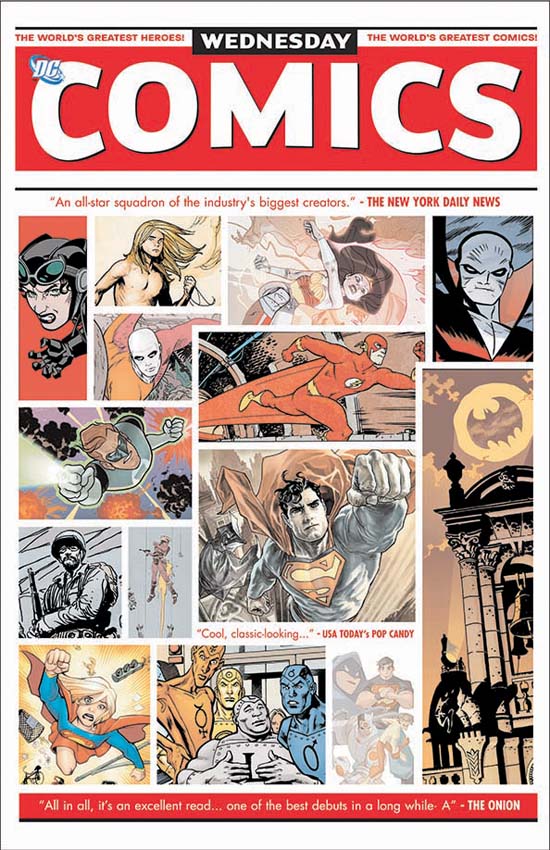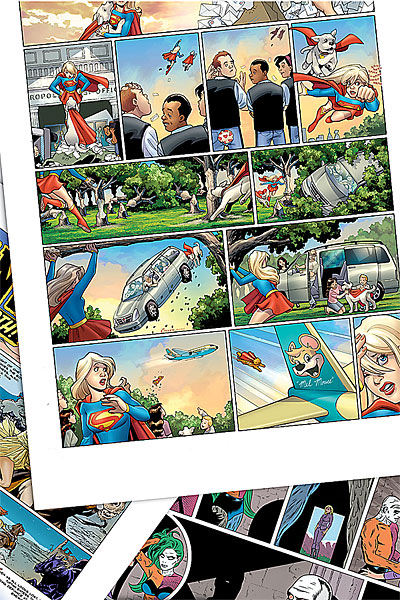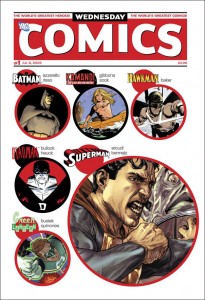 Last year, one of the highlights of my comics reading was Wednesday Comics, which was produced by DC Comics for a limited run. It featured several characters from Batman, Superman and Wonder Woman to the Metal Men and Hawkman in a weekly, newsprint format by some particularly creative folks. I enjoyed it tremendously, and DC just reprinted the series in an extra-large hardcover collection that I fell in love with at first sight.
Last year, one of the highlights of my comics reading was Wednesday Comics, which was produced by DC Comics for a limited run. It featured several characters from Batman, Superman and Wonder Woman to the Metal Men and Hawkman in a weekly, newsprint format by some particularly creative folks. I enjoyed it tremendously, and DC just reprinted the series in an extra-large hardcover collection that I fell in love with at first sight.
I came across the following article by Glen Weldon at NPR about the book, so enjoy:
>>Wednesday Comics, Collected: ‘Trippy, Experimental,’ Still Freaking Huge
Last summer, we wrote about a 12-issue comics miniseries called Wednesday Comics, which gathered some of the most notable writers and artists in comics and paired them with top-tier DC characters like Superman and Batman, as well as such deep-benchers as Metamorpho, Adam Strange, and Deadman.
That much had been done before, of course, and will be done again. What set Wednesday Comics apart was its format. DC let those creative teams loose on what was quite literally a huge canvas—each page measured 14 by 20 inches and was printed on newsprint. The result—a Sunday funnies-like broadsheet that made many adult comics readers want to spread the thing out on their living room rugs, lie on their stomachs and bust out the Silly Putty.
That last thing might just have been a me thing.
Today, the publisher releases a hardcover collection of the series. It’s not as large as the newsprint version, but it’s still huge enough, at 12 by 18 inches, to resemble the hippest/nerdiest lunch tray you’ve ever seen.
During the original run of the series, much of the online buzz focused on the writing, but seeing the whole thing collected, the art takes center stage. Panels pop, pages practically vibrate with color, and more than few double-page spreads inspire something a lot like awe.
I asked the man behind Wednesday Comics, DC Art Director Mark Chiarello, about what went in to producing the original series, how seeing the run collected changes the reading experience, and what he wanted the book to be.
Okay, this book is an object of heartstopping beauty. Not really a question, but just: You know, know that.
Jeez, I’d hate to think a comic book led to heart stoppage, but I kinda agree.
In its original 12-issue run last summer, Wednesday Comics featured 15 different stories about classic DC characters, each by different team of creators. The stories were serialized, issue by issue, into single-page comic chapters—but because each of those pages were broadsheet-huge and printed on newspaper stock, the effect was that of reading the Sunday funnies, even down to the smell of the paper.
To some (okay, to me) that seemed like you were throwing down a four-color gauntlet in the face of the uncertain digital future, offering a reminder that the pleasures we derive from comics are not solely visual. You know, “Let’s see your iPhone do THIS, chump.” Any of that intentional? Or were you simply trying to create a nostalgic object, a tribute to the days of Dick Tracy and Terry and the Pirates?
No, sir, no gauntlet-throwing intended. We just wanted to have a fun time and produce a fun, immersive reading experience.
Some people had speculated that we were trying to resuscitate an older medium (newspapers), or challenge a newer one (digital), but really, we just wanted to present our characters on as large a playing field as possible. The ultimate goal was simply a great, memorable reading experience.
 Even though superheroes like Spider-Man and Superman have been serialized in newspapers over the years, there’s something about this particular combination of format and content that feels contemporary. Some of that’s plain ol’ cognitive dissonance—every time you turn the page, you half-expect to be greeted with the thin, flavorless gruel that is Fred Bassett and Family Circus, but what you get is a Paul Pope jetpack, a hot-air ballooning tiger-man by Ryan Sook or Kyle Baker’s Hawkman whupping a T.Rex upside the snout with a mace.
Even though superheroes like Spider-Man and Superman have been serialized in newspapers over the years, there’s something about this particular combination of format and content that feels contemporary. Some of that’s plain ol’ cognitive dissonance—every time you turn the page, you half-expect to be greeted with the thin, flavorless gruel that is Fred Bassett and Family Circus, but what you get is a Paul Pope jetpack, a hot-air ballooning tiger-man by Ryan Sook or Kyle Baker’s Hawkman whupping a T.Rex upside the snout with a mace.
The disparate design aesthetics of the various artists is a big reason the thing feels fresh—how they each chose to play with oversized format, if they chose to.
When you hire Kyle Baker or Neil Gaiman or Paul Pope, you can be sure you’re not going to be bored. The reason we snagged the top creators in the comics business wasn’t just to attach big names to a new format, it was primarily because we knew this caliber of writer and artist would be challenged by the possibilities of such an enormous canvas.
I mean, just look at what Karl Kerschl and Brenden Fletcher did with their Flash story. You couldn’t and wouldn’t try to tell such a trippy, experimental story in a ‘regular’ comic book.
You edited all 12 issues, which meant you were juggling 45 different artists, writers, colorists and letterers every week. What was the brief you gave them, and what was the process like?
Jeez, I’m having a Nam flashback just thinking about it! The frontdoor brief was an easy one: I knew I had hired the best talent in the industry, so I just got out of the way and let them do what they do best.
When I initially compiled the list of characters and creators, I tried to represent every possible flavor of comic book style. There’s humor, horror, war, nostalgia, hiphop, sci-fi, and good old mainstream superhero. Something for everyone (tragedy tomorrow, comedy tonight!)
In interviews, some of the artists involved in the project mentioned that they didn’t really know some of the production specs, such as the paper stock, until they’d already handed in their 2nd or 3rd issue. You can see them making the requisite adjustments, issue by issue, but some of the colors in the early issues of the run were maybe a bit muddy.
Did you have to go back and make any production corrections for the collected edition? And did you ever seriously consider printing the collected edition on newsprint, to capture the feel (and smell!) of the original series?
Part of the initial gameplan of Wednesday Comics was knowing the vast visual difference between newsprint and high-end bright, white paper.
Knowing we’d eventually collect the series allowed us to really enjoy the look and feel of newsprint that the original series had, because we could foresee how stunning the artwork would look in the collected form. As you mentioned in your first question, yes, the collection is a thing of heartstopping beauty, but there’s still a warm spot in my heart for the newsprint issues. Who says you can’t have your cake and eat it too?!
 In the collected edition, you abandon the serialized format of the original run and organize the book into 15 12-page stories about the different characters (plus some extras). This changes the reading experience, of course, and often in very cool ways (I’m thinking of Mike Allred’s art on Neil Gaiman’s Metamorpho story, which riffs on the periodic table. In the original run, he split the table into successive chapters, but in the collected edition, it’s a gorgeous double-page spread.) Do you have any thoughts on what’s gained or lost by collecting the stories in the way you have?
In the collected edition, you abandon the serialized format of the original run and organize the book into 15 12-page stories about the different characters (plus some extras). This changes the reading experience, of course, and often in very cool ways (I’m thinking of Mike Allred’s art on Neil Gaiman’s Metamorpho story, which riffs on the periodic table. In the original run, he split the table into successive chapters, but in the collected edition, it’s a gorgeous double-page spread.) Do you have any thoughts on what’s gained or lost by collecting the stories in the way you have?
Honestly, I thought Neil was off his nut when he wrote a double page spread into his Metamorpho story. Um…Neil…this is a WEEKLY newspaper, that means ONE page per week…are you sure you know what you’re doing?
Of course Neil once again proved why he’s one of the countries’ top writers by being a half step ahead of the rest of us.
I think a lot of our fans will enjoy sitting down to read all of the Batman pages in a row, and then go on to all of the Kamandi pages, and so on. That way of organizing the stories makes the book a true anthology publication now.
A few readers of the original series had told me that they were a bit frustrated having to wait yet another week to find out what was going to happen to Catwoman or Sgt Rock. Sure, I know in the digital age, we can get everything we want the very second we want it, but I think it’s sometimes a good thing to have to wait to get something good.
Back when the first issue hit the stands, a friend who owns a comics shop bristled at the very thought of DC ever releasing … the book you’re releasing today.
“They should never collect them,” he told me, eyes blazing. He picked an issue off his shelf, opened it and sort of flapped it at me. “This is the format these stories were MEANT be experienced in.”
I won’t disagree with your friend, but DAMN, this collection is awfully cool! Surely when he closes up the comic shop this Wednesday night and takes his copy of Wednesday Comics home with him, he’s gonna be a happy fella.<<
Here’s a somewhat long-ish review of the book as told by a fan as he unwraps it from a box sent by Amazon:
« ‘Mouse Guard: Legends Of The Guard:’ Buy This Book! DC-Area Serial Rapist Remains At Large – 1 »
